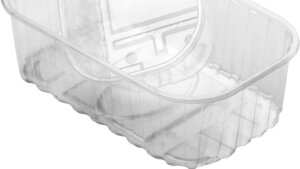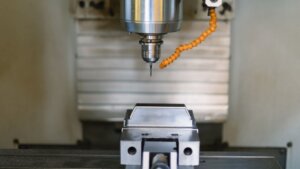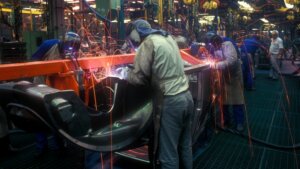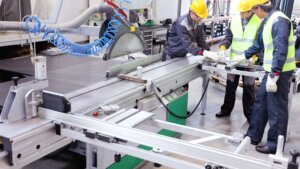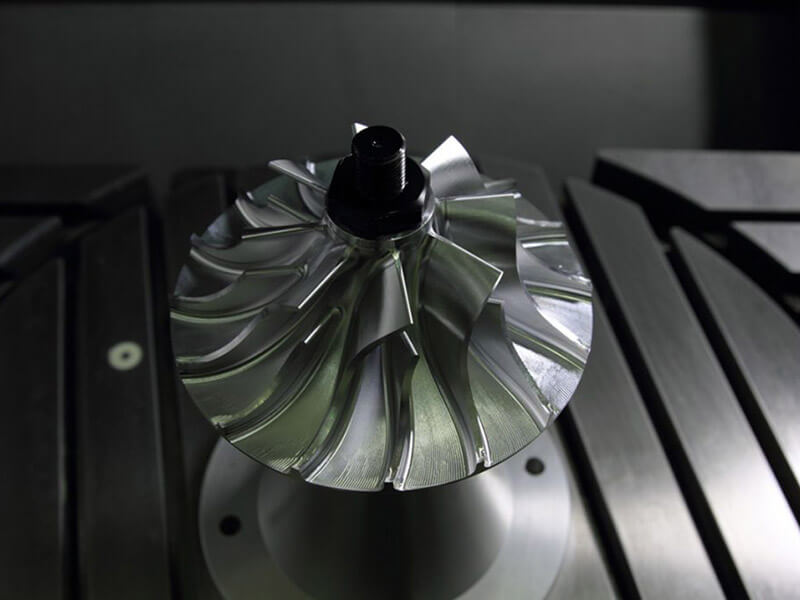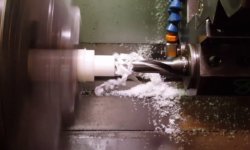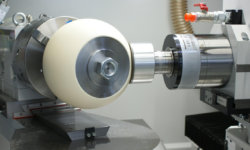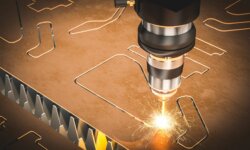Plastic machining is one of the most common industrial processes due to the high usage of this material. However, modern-day plastic CNC machining isn’t what it used to be. Plastics nowadays can be built strong enough to stop a bullet’s impact. This calls for a very rugged machining method.
CNC machining plastics has become a great solution for these requirements. Plastics have a lot of variety, with differences in physical properties and chemical structure. All of these varieties are easy to machine with CNC machining.
This article will explore the applications of CNC machining of plastic materials. It will go into the details of different kinds of CNC machined plastic parts and their physical properties. You can decide which plastic materials best suit your job requirements based on the information provided here.
What is Plastic CNC Machining?
Plastic CNC Machining is a CNC machining process that uses Computer Numerical Control (CNC) technology to automate machining of plastic materials. This is achieved through computer programming guiding the machine tools.
While CNC machining technology supports a variety of materials, such as metals, alloys, glass, wood, and ceramics, this specific term refers to its application in plastic machining.
Can Plastics Be CNC Machined?
Yes, CNC machining plastics is possible. In fact, CNC machining is the best way to make plastic components. This is because of the high accuracy and speed of this process. The quality of plastic CNC machining is way ahead of other alternatives like injection molding or 3D printing.
What Are the Common CNC Machining Plastics?
Any plastic can undergo CNC machining. Some common plastics that use this process are:
Nylon (PA)
Nylon has good chemical resistance and heat resistance. Therefore, nylon usage is commonly found in applications such as insulations and sheaths. Nylon spacers are used in circuit breakers for the electronics sector. Commonly used processes on nylon are CNC mills and lathes. There are many different grades of nylon. Nylon 6/6 is a common type used in plastic CNC machining.
Advantages
- Very cheap cost
- Lightweight
- High heat resistance
- Does not catch fire
- Retains color
- Durability
- Good finishes
Disadvantages
- Tendency to melt at high temperatures
- Hygroscopic
Uses
- Clothes
- Fishing lines
- Fishnets
- Conveyors
- Seatbelts
- Parachutes
- Camping gear
Polyethylene (PE)
Polyethylene is also known by its common name Polythene. It is the most commonly used and produced plastic type. The high popularity of polythene has led to the emergence of several different types. Two of the commonly found polythenes for plastic CNC machining are LDPE and HDPE.
Low-Density Polyethylene (LDPE)
LDPE has low tensile strength, high ductility, and low density. Common applications of LDPE are for making trays and foils in the packaging industries. It has very low moisture absorption.
High-Density Polyethylene (HDPE)
HDPE has better physical properties than LDPE. The main attractive points of HDPE are its high density and tensile strength. Plastic bottles and pipes are made of HDPE material.
Advantages of POlyethylene
- Large variety available
- Very cheap cost
- Lightweight
- Water resistance
- Flexible
Disadvantages of Polyethylene
- Environmentally harmful
- Made from fossil fuels
- Produces greenhouse emissions
Uses
- Food packaging
- Bottles
- Pipes
- Trays
- Grocery bags
- Trash bags
- Insulations
- Toys
Polyethylene Terephthalate (PET)
Polyethylene Terephthalate (PET) is in the subclass of polyester plastic materials. It is the major constituent of packaging in the food and beverage industries. It is a hygienic, water-resistant, and lightweight material. It is also one of the easy-to-machine plastics used in plastic CNC machining projects.
Advantages of PET
- High strength-to-weight ratio
- Cheap cost
- Hygienic
- Food grade
- Recyclable
Disadvantages of PET
- Non-biodegradable
Uses of PET
- Water bottles
- Jars
- Rope
- Automotive parts
- Protective packaging
Polyvinyl Chloride (PVC)
PVC is one of the most popular plastics used for its high strength. It is a very durable material with high tensile strength, lightweight nature, and chemical resistance. There are many different forms of PVC available for different applications.
Advantages of PVC
- High chemical resistance
- Electrical insulating properties
- Dimensional stability
- Corrosion resistance
- Waterproof
Disadvantages of PVC
- Tendency to cracking at elevated temperatures
- Non-decomposing
Uses
- Drainage pipes
- Water service pipes
- Window frames
- Medical equipment
- Blood bags
- Insulation
- Automotive interior parts
Chlorinated polyvinyl chloride (CPVC)
Chlorinated Polyvinyl Chloride is derived from PVC itself. CPVC is obtained after successive chlorination of PVC resin. CPVC has improved properties than PVC plastics. The purpose of CPVC is to eliminate the vulnerability of PVC to temperatures during the plastic CNC machining process.
Advantages of CPVC
- High-temperature resistance
- Highly flexible
Disadvantages of CPVC
- Brittle
- High thermal expansion coefficient
Uses
- Cold water delivery system
- Hot water pipes
- Plumbing
- Vents
Polycarbonate (PC)
Polycarbonate is a type of thermoplastic polymer. More than one billion kg of Polycarbonate is manufactured annually. This is because of the high-grade physical properties and widespread PC applications.
Advantages of PC
- High strength
- High toughness
- Can be a transparent thermoplastic
Disadvantages of PC
- Prone to scratches
- Price is not cheap
Uses
- Safety glass
- Bulletproof glass
- Room divider
- Electronics
- Construction
Polypropylene (PP)
Polypropylene is also known by its common name Polypropene. It belongs to the thermoplastic polymer category. Its properties are a slight improvement to polythene.
Advantages of PP
- Cheap price
- High flexural strength
- Good chemical resistance
- Moisture resistance
- Repairable
- Low coefficient of friction
Disadvantages of PP
- Flammable
- Hard to paint
- Degrades in UV light
- High thermal expansion coefficient
Uses of PP
- Machine parts
- Flexible packaging
- Rigid packaging
- Tote bags
- Bottle caps
- Medical equipment
Polyphenylsulfone (PPSU)
Polyphenylsulfone is an aromatic ring polymer. It is an easy-to-machine plastic. It is also moldable with injection molding. It is a high-performance thermoplastic.
Advantages of PPSU
- Highly impact resistant
- Withstands high temperatures
- Sterile material
- High chemical resistance
- Food grade
- Washable
- Durable
Disadvantages of PPSU
- High fouling tendency
Uses
- Water bottles
- Baby milk bottles
- Aircraft bezels
- Sterilization trays
- Medical equipment
Polysulfone (PSU)
Polysulfone is another high performance thermoplastic like PPSU. PSU parts can be used in a wide range of temperatures. Common range is -100°C to 200°C. The temperature range makes them one of the highest service temperatures of plastic.
Advantages of PSU
- High thermal stability
- Chemical inertness
- Flame retardant
- High hydrolysis stability
Disadvantages of PSU
- No resistance to solvents
- Hydrophobic
Uses
- Waste water recovery systems
- Hemodialysis systems
- Gas separation
- Food and beverage equipment
Polyphenylene sulfide (PPS)
PPS is known by a lot of different names due to various brands manufacturing it. Some common brand names are Durafide, Petcoal, Ecotran, and Fortron. It is a high temperature thermoplastic polymer.
Advantages of PPS
- High-temperature resistance
- Flowability
- Chemically resistant
- Dimensional stability
- Good electrical insulation
Disadvantages of PPS
- Notch sensitive
- Poor tracking resistance
Uses
- Coal boiler filter fabric
- Film capacitors
- Gaskets
- Specialty membranes
- Packing
Polyetherimide (PEI) – Ultem
PEI is an amorphous thermoplastic. Its color spectrum can vary from amber to transparent. It provides a cheaper alternative to PEEK thermoplastic with similar properties.
Advantages of PEI
- Transparency
- Adhesive properties
Disadvantages of PEI
- Lower impact resistance
Uses
- 3D Printer beds
Ultra High Molecular Weight Polyethylene (UHMW)
Ultra-high molecular weight polyethylene is a subtype of Polyethene thermoplastic. It also goes by High Modulus Polyethylene (HMPE). It has a good load-handling capability due to long-chain polymers.
Advantages
- Highest impact strength among all thermoplastics
- High abrasion resistance
- High toughness
- Odorless
- Non-toxic
Disadvantages
- Low melting point (around 130°C)
- Creep deformation under long stress
Uses
- Bearing material
- Idler roller
- Chain guide
- Machine parts
- Gears
Polyoxymethylene (POM or Acetal)
Acetal is one of the most used plastics in CNC machining. It also goes by its other name Delrin. It is a very easy to machine plastic.
Let’s explore some of the Delrin machining characteristics.
Advantages
- It can be visually appealing
- Heat resistance
- Wear resistant surface
- Weather resistance
- Chemical resistant
- Impact resistant
Disadvantages
- Poor resistance to acids
- Difficult to bond
Uses
- Seat belt parts
- Electronic Cigarettes
- Insulin pens
- Water meter
- Guitar picks
Polystyrene (PS or Styrofoam)
Polystyrene is a solid of foamed polymer. The foamed variety has been patented and the trademarked name goes by Styrofoam. Styrofoam is actually an Extruded Polystyrene (XPS). DuPont owns the trademark of styrofoam and manufactures it globally. 98% of styrofoam is air, leading to its foamy nature.
Advantages
- Lightweight
- Buoyant
Disadvantages
- Environmentally harmful
Uses
- Building material
- Insulation sheets
- Art and crafts
Acrylonitrile Butadiene Styrene (ABS)
ABS is another popular CNC machining plastic. It is a thermoplastic polymer. It has impressive physical properties which lead to a lot of applications find different industries.
Advantages
- Good impact resistance
- Toughness
- High rigidity
- Good stability under load
Disadvantages
- Low melting point
- Poor response to UV exposure
- Poor weather resistance
Uses
- Hard hats
- Helmets
- Vacuum Cleaners
- Printers
- Musical Instruments
- Kitchen Utensils
Carbon Fiber (CF)
Carbon fiber is basically Carbon Fiber Reinforced Polymers (CFRP). It has thin strands of carbon fiber added to a base plastic for improved properties. It is classified as a composite material.
Advantages
- Extremely strong plastic
- Lightweight
- High rigidity
- High strength-to-weight ratio
Disadvantages
- Expensive
- Conducts heat
- Poor electrical insulation
Uses
- Aerospace
- Machine tool spindles
- Robotic arms
- Power transmission shafts
Polytetrafluoroethylene (PTFE or Teflon)
Teflon is a brand name of polytetrafluoroethylene. It is patented by Chemours. Interestingly, Teflon was also discovered by DuPont, which already holds the trademark for Styrofoam. Chemours was branched from DuPont and is the global manufacturer of Teflon.
Let’s get into more details of using Teflon for CNC machining.
Advantages
- Non-stick
- Heat resistance
- Cold resistance
- Comes in a coating form
- Long service life
Disadvantages
- Costly
- Difficult to mass produce
- Deforms under pressure
- It cannot be welded
Uses
- Non-stick cookware
- Abrasion-resistant coating on automobiles
- Coating surgical equipment
Poly(methyl methacrylate) (PMMA) or Acrylics
PMMA goes by a lot of different names, such as Acrylic and Acrylic Glass. Many other brand names exist, like Lucite, Plexiglass, Perclax, Perspex, etc. Its high transparency is why Acrylic finds many applications in machining, replacing the traditional glass.
Advantages
- Shatter resistance
- Optical clarity
- Transparency
- It can be joined with superglue.
- It can be heat welded.
- It can be joined with chlorinated solvents.
Disadvantages
- Vulnerable to scratches
- Cannot withstand very high temperatures
Uses
- Kitchen Backsplash
- Glass cabinets
- Home Decor
- Picture frames
- Wall shelves
- Tables
Polysiloxane (Silicone)
Polysiloxane is a colorless, rubber-like substance also called Silicone. It is used for many plastic CNC machining applications in electronics, household, electrical, automobile, and aviation manufacturing industries.
Advantages
- Creasing and wrinkling resistance
- Thermal stability
- Low toxicity
- No microbiological growth
- Water repellant
Disadvantages
- Poor tear strength
- Poor abrasion resistance
Uses
- Lubricants
- Sealants
- Adhesives
- Thermal insulation
- Electrical insulation
Poly Paraphenylene Terephthalamide (Kevlar)
Poly Paraphenylene Terephthalamide usually goes by its common names kevlar and twaron. It is one of the most popular aromatic polyamides globally. It is a synthetic fiber developed by DuPont. Its physical properties are comparable to or even better than metals and alloys.
Advantages
- Extremely high strength
- High impact resistance
Disadvantages
- Hygroscopic
- Weakness to compression
- Expensive
Uses
- Racing tires
- Bicycle tires
- Bulletproof vests
- Armor
Acetal copolymer (Celcon)
Celcon is a high-performance acetal polymer that works in a wide range of temperatures. It is resistant to most adverse conditions and has a long service life. There are many subtypes of Celcon, like UV-resistant, wear-resistant, glass-reinforced, bleach-resistant, impact resistant. etc.
Advantages
- Moisture resistant
- Fuel resistant
- Excellent chemical resistance
- Good dimensional stability
- Long term fatigue resistant
Disadvantages
- A certain level of toxicity
Uses
- Fuel systems
- Plumbing applications
- Gears
- Springs
- Clips
Polyphenylene oxide (PPO)
PPO is a high-temperature thermoplastic. It is a hard-to-manufacture material. Therefore, it is generally used in its blended form. It is also known as Polyphenylene Ether (PPE). It has quite good performance characteristics. It is mixed with Polystyrene to improve its physical chacteristics.
Advantages
- High-performance plastic
- Good temperature handling
- Radiation resistant
- Low moisture absorption
- Good dimensional stability
- Chemical resistant
- High abrasion resistance
Disadvantages
- Costly
- Difficult to manufacture
Uses
- Electronics
- Structural parts
- Sterilization instruments in healthcare
- Automotive parts
Kapton
Kapton is a special type of polyamide film. DuPont invented it. It has one of the best temperature handling amng all plastics. It can sustain temperatures between -269°C to 400°C.
Advantages
- Extreme temperature handling
- Good mechanical properties
- Shape retention in high temperatures
Disadvantages
- Vulnerable to radiation damage
- Mechanical properties degrade with aging
Uses
- Space blankets
- Flexible Printed Circuit Boards (PCBs)
- 3D Printing
- Space applications
Polyethersulfone (PES)
PES plastic is available in blocks, sheets, and rods. It is also sometimes referred as PESU. These plastics have great physical properties and temperature handling. The color of PES is reddish brown with good transparency.
Advantages
- Good dimensional stability
- Good temperature handling
- Can withstand high temperatures for extended periods
- High mechanical strength
- Rigidity
- Hydrolysis resistant
Disadvantages
- Rough surface
- Hydrophobic
- Membrane fouling
Uses
- Dialyzer membranes
- Surgical theater luminary
- Infusion equipment
- Sterilization boxes
Polyvinylidene fluoride (PVDF)
PVDF is a chemically inert thermoplastic. It is a special kind of plastic used in very niche applications. The main use case for this plastic is when a highly non-reactive material is required. PVDF can resist any chemical. It can be obtained in many different forms, like pipes, sheets, powder, tubes, plates, and films.
Advantages
- It can be welded
- High chemical inertness
- It does not degrade with acids
- Resistant to solvents
- Non-toxic within temperature limits
Disadvantages
- High dissipation factor
- Fouling
Uses
- Defense equipment
- Chemical industry
- Semiconductor manufacturing
- 3D printer filament
- High gloss metal paints
Thermoplastic elastomers (TPE)
TPE is also sometimes termed as Thermoplastic Rubber. It is a mix of different polymers, often plastic and rubber. TPE is different from conventional elastomers, which is thermosetting in nature. However, the thermoplastic properties of TPE allow the application of many different manufacturing methods.
Advantages
- Good elongation
- Returns to original shape after elongation
- Long service life
- Higher physical range than alternative plastics
Disadvantages
- Below-average heat resistance
- Significant degradation in physical properties with temperature rise
Uses
- Cables and wires
- Toys
- Automotive parts
- Shoes
- Sports equipment
- Consumer goods
Thermoplastic polyurethane (TPU)
TPU is a wide class of Polyurethane (PU). It can exhibit a range of different properties. It is easy to machine with CNC, extrusion, and injection molding. It can also be shaped with calendering. Due to the wide range of manufacturing processes, TPU scrap can be recycled over and over.
Advantages
- Easy to machine
- Wide range of manufacturing processes
- Recyclable
- Elasticity
- Transparency
- Oil resistant
- Grease resistant
- Abrasion resistant
Disadvantages
- Some types have a short shelf life
- Not cost-effective
Uses
- 3D printer filament
- Automotive instrument panels
- Power tools
- Sports equipment
- Caster wheel
- Footwear
- Inflatable rafts
- Fire hoses
Polyetheretherketone (PEEK)
PEEK is a very popular CNC machining thermoplastic. It is colorless in pure form. Its melting point is 343 °C, which makes it good for high-temperature applications. Operating temperatures of many PEEK subtypes easily go up to 250 °C.
Advantages
- Resistant to thermal degradation
- Good operating temperature
- Chemical resistant
- Good mechanical properties
Disadvantages
- Expensive
- Degrades in UV light
- Does not biodegrade
Uses
- Water pumps
- Aerospace parts
- Medical implants
- Bearings
What CNC Machining Process is Most Suitable for Plastics?
All CNC processes work well for plastic CNC machining. CNC mills and lathes are some of the most common machines used for these materials. Other processes like CNC drills and waterjet cutters also provide good results for plastic machining.
Applications of Plastic CNC Machining
There are many use cases for using CNC machining for working on plastic materials. Some of these applications are:
Automotive Industries
Plastics are used for making a lot of different parts in the automobile sector. Interior parts such as linings, handles, and dashboards are plastic. Even exterior components like bumpers use plastics. Other miscellaneous plastic components are engine covers. electronics housing, etc.
Oil and Gas Industries
The chemical resistance of plastics has many applications in the oil and gas industry. Plastics make seals and containers for oil extraction and storage. Electrical connectors in heavy mining machinery are also made of plastic.
Food Processing
Plastic is used extensively in the food processing industry as a primary and secondary packaging material. Food-grade plastic containers are machined with CNC to provide a safe storage option. CNC-made plastic trays provide an impact-resistant transportation option for food items.
Agriculture Industries
Plastics are widely used in the agriculture sector for a variety of equipment. They are applied for making irrigation and drainage solutions. Plastics are applied for making sillage and nets. Agricultural components like greenhouses, planters, and tools also increasingly use plastics.
Aerospace
Several plastics have a high impact and corrosion resistance. This makes them ideal for making parts that face extreme pressure, like valves and pumps. Plastics like thermosetting polyimide also make structural components for the aerospace sector.
Healthcare Industry
CNC-machined plastics are used for making implants and many other devices. Electronics enclosures of medical devices like pacemakers, vitals monitoring, and others are made with high-grade plastics. Many plastics have a wear-resistant surface and resistance to stress cracking. This is why they are beneficial for making implants.
Electrical and Electronics Appliances
Cases of appliances like TV, laptops, and smartphones are made with CNC-machined plastics. These CNC machines are accurate and provide the consistent results required in this sector.
How to Choose the Right Plastic For Your CNC Project?
There are many different plastics to choose from for whatever you manufacture. The choice of plastic should be done by evaluating the various parameters that influence the decision. Some of these factors are:
- Hardness and Strength: Hardness and strength are the primary consideration when choosing plastics. The plastic should be strong enough to bear the weight and impacts of the particular applications for the part.
- Chemical Resistance: Chemical resistance is important when plastic undergoes harsh conditions.
- Moisture Resistance: Moisture resistance is a parameter for plastics that will face high humidity. Outdoor applications also require moisture-resistant plastics.
- Appearance: The appearance of plastic is important when aesthetically appealing parts are required. This is vital for use cases like toys. Sometimes, a transparent thermoplastic is used when visibility is required.
- Heat Resistance: The heat resistance of plastics is important for outdoor applications, thermal applications, and even electrical insulators.
- Budget: Plastics have a wide budget range. Materials like polythene and nylon can be very cheap. At the same time, high-strength plastic composites can be expensive.
Where to Find a Good Provider For Plastic CNC Machining?
Getting a CNC machine can be a very costly investment. This is why there is a new trend where manufacturers choose to outsource the CNC machining of plastic materials.
3ERP is the market leader for plastic CNC machining services and parts. 3ERP’s CNC machined plastics are high-quality parts that work better as intended. 3ERP uses the most advanced CNC machinery to fulfill any complex requirements that you might have. The manufacturing time is quite low, and you get your parts as soon as you require them. Contact 3ERP to get a quote for your project.
Endnotes
CNC plastic machining is the go-to process for plastic materials when quality and precision are important. Injection molding fails tremendously in terms of consistency and precision. Additionally, additive manufacturing techniques work only for plastics that can be molded by heat. If you want to use plastic material for your next project, 3ERP CNC plastic machining services can be the perfect fit.
Frequently Asked Questions (FAQs)
1.What is the strongest plastic for CNC machining?
Polyamideimide is the strongest plastic for CNC. It has a tensile strength of over 21,000 psi. Even with this extremely high strength, it is easy to machine with a CNC.
2. What is the cheapest plastic for CNC machining?
Polyethylene (PE) is the cheapest plastic for CNC machining. Known for its affordability and excellent machining properties, PE is used widely in a variety of applications, including wear strips, gears, and consumer goods.
3. What is the most commonly used plastic for CNC machining?
Acetal (Delrin) is the most commonly used plastic for CNC machining. It offers superior strength, stiffness, and dimensional stability, making it a popular choice for precision parts in automotive, electronics, and industrial machinery applications.
4. What is the hardest plastic to CNC machine?
PEEK (Polyether Ether Ketone) is among the hardest plastics to CNC machine. Its high thermal and chemical resistance, along with its strength, makes it difficult to machine but desirable in demanding environments like aerospace or medical fields.
5. What is the easiest plastic to CNC machine?
ABS (Acrylonitrile Butadiene Styrene) is typically the easiest plastic to CNC machine. Known for its excellent machinability, ABS is used frequently in prototyping and manufacturing applications due to its ease of use and strong, durable properties.



